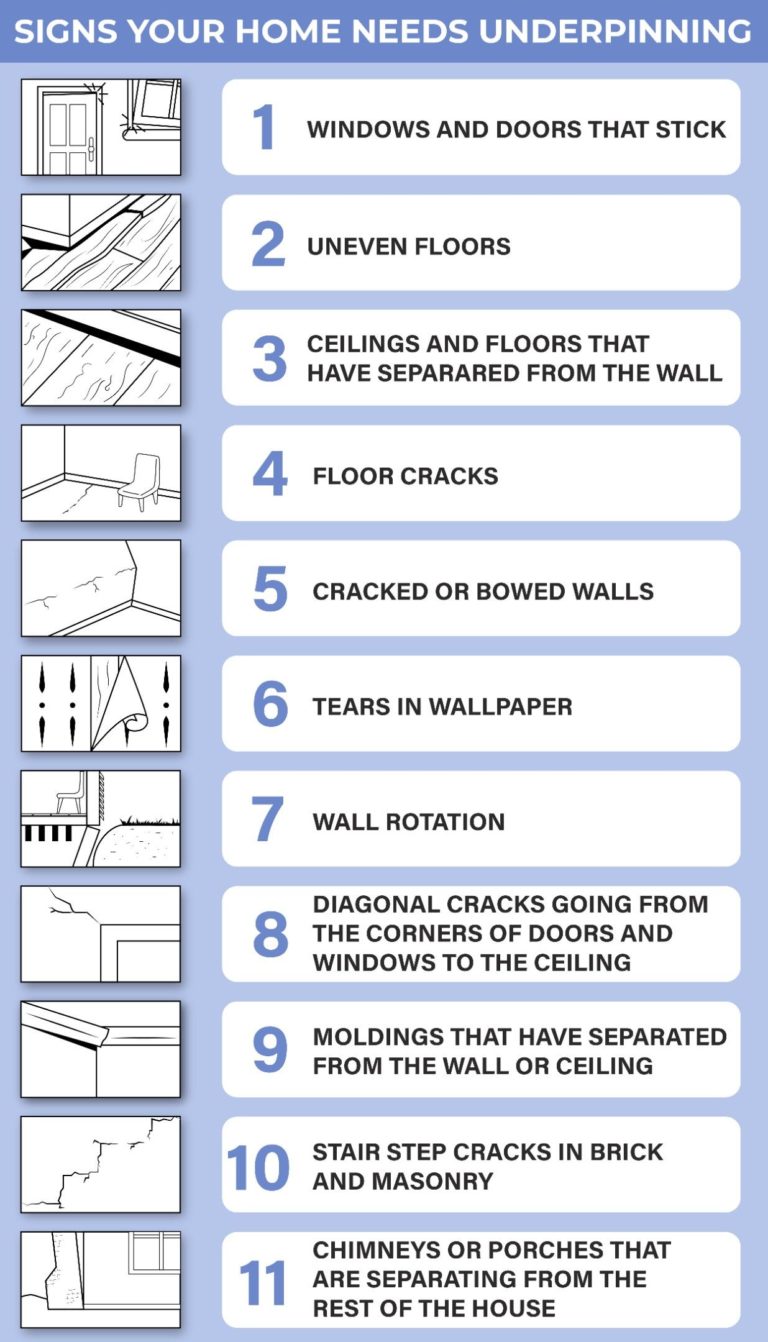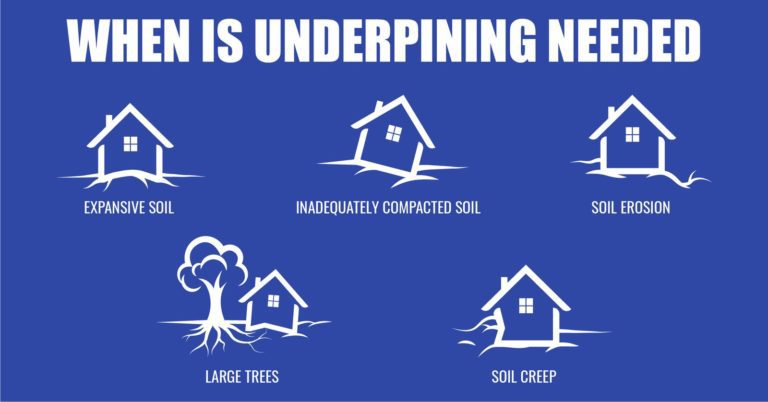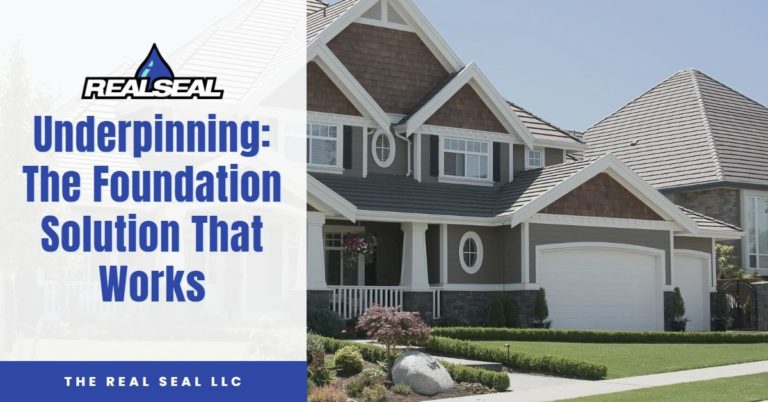Have you ever heard of the term underpinning? Are you somewhat familiar but want to know more? Follow along! Here you will learn the definition, benefits, methods of underpinning.
What Is Underpinning?
Underpinning is used when a home’s load is too much for the soil that lays below it. Using special tools and machines, the load is transferred down to the soil that can support the house. These tools are called piers and go deep down past the weak soil until they reach what’s called the load-bearing strata (the underlying soil or rock that can bear the weight of a building or structure without shifting or compressing).

Underpinning stops settlement, strengthens the current foundation, and increases your home’s value.
Signs Your Home Needs Underpinning
Signs your home might need underpinning include:
- Windows and doors that stick. This is a common sign of a foundation settling.
- Uneven floors. Floors that are sunken, sloped, or bowed are apparent signs of foundation problems.
- Ceilings and floors that have separated from the wall. These don’t need to be large, highly noticeable separations. Slight separations can be a serious structural problem.
- Floor cracks. Look for floor cracks that run in a straight line. Floor cracks caused by dropping something on the floor are usually limited to one or two tiles.
- Cracked or bowed walls. The wall could either be on the exterior or interior of your home.
- Tears in wallpaper. This could be a sign that the wall behind the wallpaper is cracked.
- Wall rotation. This happens when the soil under a foundation has a lot of water in it. The building’s weight pressing down on the foundation will cause the foundation’s outside edge to sink deeper into the saturated soil. Meanwhile, the inside edge of the foundation – which sits atop drier soil – pulls up. This results in the wall rotating.
- Diagonal cracks going from the corners of doors and windows to the ceiling. If these are very thin hairline cracks, it might be from normal settling. However, larger cracks could be a sign of foundation damage.
- Moldings that have separated from the wall or ceiling. This happens because the floor, ceiling, and walls are no longer moving as one unit.
- Stair step cracks in brick and masonry. This is another sign of foundation trouble. Sometimes these cracks will be in the mortar only.
- Chimneys or porches that are separating from the rest of the house. There’s a chance this might be related to a problem with the foundation under the chimney or porch. However, a professional should look at it to make sure it isn’t caused by a problem with your home’s foundation.

Read more about – Common Causes of Honeycomb in Concrete
When Is Underpinning Needed
Underpinning a home is usually needed when the soil below the foundation is weak, not the foundation itself. Problems with soil include,
- Expansive Soil – Soil that contains a lot of clay is called expansive because it swells when it gets wet and shrinks when it dries. This swelling-shrinking cycle creates movements in the soil, putting stress on the foundation.
- Inadequately Compacted Soil – Soil that’s taken out of a construction site and is then put back needs to be well compacted before a structure is built on top of it. If the soil isn’t well compacted, the structure could then settle unevenly.
- Soil Erosion – Usually happens when there is poor drainage around the home.
- Large Trees – Trees can drink all the water and dry out the soil, creating voids under the foundation.
- Soil Creep – Soil creep is where soil at the top of a hill makes its way down the hill. Soil creep can cause lateral movement in homes built on hillsides.

Other problems that might make underpinning necessary include,
- Natural Disasters – Earthquakes, floods, drought, and sinkholes can all cause structural damage.
- Poor Construction – Sometimes the problem isn’t the soil, but how contractors built the house. Maybe the contractor built the house without understanding the soil type.
- Renovations – Adding a story to a house will add significant weight to the foundation. This may require underpinning a home before the new construction starts.
Common Underpinning Methods
Types of underpinning methods include:
- Steel Piers – Some of the most common foundation repair solutions. They’re driven deep into the soil until they hit the load-bearing strata. The structure can sit atop the piers, and hydraulic jacks lift the structure to the correct position.
- Helical piers work in a similar sense but through a different drilling method. Helical piers look like giant corkscrews and are twisted into the ground until they reach stable soil. The torque necessary to drive them into the soil determines load-bearing capacity. Synchronized Hydraulic jacks then raise the building.
Who To Call For Underpinning
The repair solutions described above are not DIY projects. So, you’ll need to call a pro. Why not call an award-winning and outstanding company? If you need underpinning in the Chicagoland area, call The Real Seal! We specialize in foundation repair, crawl spaces, basement repair, waterproofing, and more.







9 Responses
It helped me when you said that underpinning is used when a home’s load is too much for the soil that lays below it. Our house is an inheritance house from my parents. Since it is old, I can’t deny that its foundation is getting weak. Good thing your post has all information on how to find residential underpinning services. I will hire one these days.
Happy to help, Jeff! Thanks for commenting, let us know how we can help!
Thanks, Jeff! Let us know if we can help in any way!
Thank you for explaining that adding a story to the house could make underpinning necessary for your foundation. My friend is thinking about adding a story to her home to make more room for her family to spread out. I’ll be sure to mention this to her so that she can see if it’s something she’ll need to talk to the contractor about to keep her foundation sturdy.
Happy to help, Olivia! Thanks for the feedback, we’re always trying to educate!
Thanks for the info about underpinning. My dad wants to remodel his home. I think he’ll find this info about underpinning helpful.
You bet, thanks Max!
I like that you pointed out how residential underpinning is used when a house’s load is too much for the soil that lays below it. I noticed that our house foundation got some minute cracks on them, which is a bit alarming. The cracks may be small for now but it could get worse later on, so we should definitely have some professionals look into it.
Hi Luke! Always a good idea to get a professional to assess the cracks in your home. Some may be small and only waterproofing, but they could also end up being structural. Just like the doctor, it’s best to go early and often to avoid the really big bills.